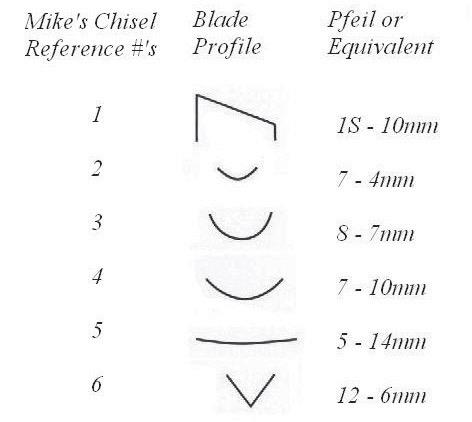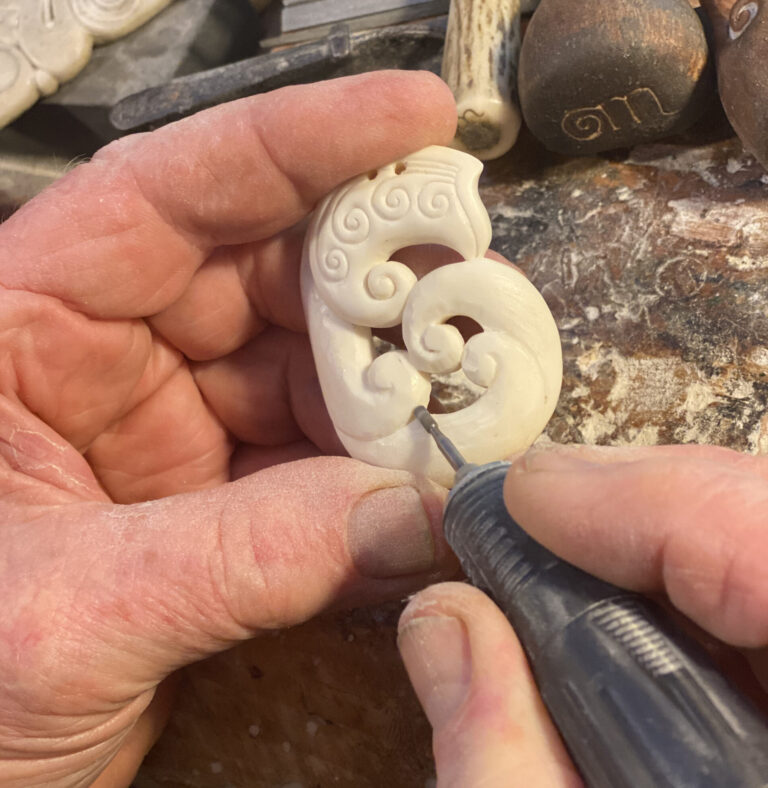Learn to carve this stylish emblem of old England
By Mike Davies
An aspiring woodcarver who builds on a solid foundation of knowledge and technique will soon be creating impressive carvings. To demonstrate basic knowledge and techniques, we are going to follow the carving of a Tudor rose.
I make the scale of the work to suit the scale of the chisels and I have designed this project to fit the scale of the six chisel profiles mentioned. These are the profiles of an ideal beginner’s toolkit and will be the only chisels required for this project.
FIVE BASIC TECHNIQUES
There are five basic techniques for good woodcarving. They may seem a little awkward at first, but persevere and soon they will become second nature.
Ambidextrous
When carving you will need to cut in many directions, not only to achieve the desired shape, but also to accommodate the timber’s grain. You should always try to remain centrally located in front of the carving. When carving to the left, hold the chisel in your left hand and vice-versa for the right.
Ambidextrous: Right-handed (carver working from the right)…
…left-handed (working from the left).
Anchoring
Part of the hand or arm of the hand that is holding the chisel should at all times remain in contact with the work or bench. This will prevent any unwanted slips. The anchor will ensure that you have a “brake” for the chisel. You should never apply a greater force than controlled arm-weight to the chisel. If more force is required, use a mallet to tap the handle of the chisel. It is important that the anchor remains in place during each tap of the mallet so that after the impact, the chisel blade returns back to its original position. If you need to advance the cut for-ward, then reposition the anchor.
Anchoring while using mallet.
Anchoring
Pinch position
Pinch the blade of the
chisel between fingers and thumb around 25 mm from the cutting edge. This position is used for light work or for setting in a cut where the shaft is around 90 degrees to the timber’s surface.
Pinch position
Fist position
Close your fist around the shaft of the chisel so that around 25 mm from the cutting edge is protruding. The cutting edge should always be next to your little finger and your knuckles should always be pointing upwards. When you are holding the chisel, as the anchor try to use the ball of your hand just below your wrist.
Fist position.
Sliding
When carving timber, try to think of the way you use a knife to cut through bread. If you were simply to use a down-ward pressure with the knife on the bread the resulting cut would be ragged and torn. The same applies to the carving chisel.
Where you start, you need to have the tip in the timber otherwise you will pull out the fibre of the wood. As you move the chisel forward, try to slide the blade from side to side at the same time. This can only be done when using arm weight to move the chisel, as it is the hand that is pushing the chisel forward that rotates the handle at the same time.
Sliding
Sliding
ABOVE: Chisels and… …chisel profiles.
Carve a Tudor rose
The Tudor rose has been a commonly used English decoration in paintings, tapestries, stonework and timber, depicting the union of the Lancastrians and Yorkists following the English War of the Roses back in 1485. This does not reproduce an exact flower but is a stylised five-petal model. I am making this carving out of oak. Although it’s a hard timber, you should be able to work it with no more than sharp chisels and the pressure of your hand and arm.
The first problem is knowing how to hold the chisel. It’s surprising, but you get people holding the chisel upside down and other clumsy ways. There’s an awful upside-down fist grip people try which is bad—the chisel is awkwardly held, there is with no anchor and the result will be the chisel digging in. Then there is the correct way to hold and use the chisel. (See Five Basic Techniques.)
Mark out the Tudor rose onto your timber by recreating the design on your own grid of squares. To ensure that your scale is accurate, mark each square at 20 mm. You could make a photocopy of the finished-drawing and cut out the design to make a template, or simply trace the design onto your timber using carbon paper.
Design template
Cut out design
Trace design on wood
Perimeter
Use chisel profile number 5 to set in the outside perimeter of the large rose petals, the small rose petals and the inner circle. You can also use chisel number 5 to set in the barbs between the larger petals. Hold the chisel using the pinch position and make sure that the chisel shaft is 90 degrees to the timber surface. Now, using chisel number 5 in the fist position, cut down at 45 degrees from the outer circle to meet the set-in cuts of the large rose petals and the barbs. Practise the sliding technique as you carve down and try to ensure that each cut is clean. Keep setting in your vertical cuts so that the chips are cleared as you go. Remember to stay centrally located in front of your work. Hold the chisel in the right hand to carve right and vice versa for the left.
Using pinch position, set in outside perimeter of large and small petals and inner circle. Note work fixed to bench
Chisel No 5 in fist position cuts down at 45 degrees from the outer circle
Barbs
Next use chisel number 5 to shape the barbs between the larger petals. Mark a pencil line from the tip of the barb radiating towards the middle of the centre circle. Then using chisel number 5, carve down from the centre line to meet the edge of the larger petals. Take a look at the finished picture to see the required shape. The goal will be to form a high, straight ridge along the centre of each barb.
Shape the barbs between larger petals
Scoops
Using chisel number 4, begin to shape the inside of each of the larger petals. Create two scoops leaving a high ridge in the centre of each petal. Once this has been completed, do the same for the smaller petals with chisel number 3.
Set in the curve on the inside edge at the tip of each petal using chisel number 5. Then carve down to-wards the cut to clear the waste. The same should now be done for the smaller rose petals using chisel number 4.
Now take the scoop from the middle of each of the large petals with chisel number 4. This should create two ridge lines that run to-wards the centre. Complete the same for the smaller rose using chisel number 3 or 2.
Shape scoops inside each petal with chisel No 4
Scoop from the middle creates ridge lines
Carve down towards the cut to clear waste
Carve where two petals meet
Petals
With chisel number 1, carve the area where the two petals of the larger rose meet to fall down towards the smaller rose. Then do the same for the smaller rose petals where they fall away to the centre circle. With chisel number 6, create a V-line be-tween each of the petals and round over the edges of the petals using chisels 1, 4 and 5 as appropriate. Remember to use the finished picture to ensure that you achieve the correct shape.
Use dividers to create a circle. Set in division lines with chisel No 1
Use chisel No 2 to round over the seeds
Round over the edges of the petals
Centre
To complete the design, in the centre set in a circle with chisel number 2. Create eight equal divisions radiating out from the centre within the inner circle. Use chisel number 2 to set in an arc at the widest point of each division to form a continuous line of arcs around the centre circle. With chisel number 1, set in the division lines of each of the eight segments and carve down towards the set-in cut at 45 degrees.
This should create a series of valleys that radiate towards the centre. Use chisel number 2 to round over each of the seeds. Use chisel number 1 to assist with cleaning the work as you go. Finally, a light sanding may be required to perfect the shape and lines of your decoration. However, be careful not to lose the definition of your chisel work.
Mike Davies is the author of the book Woodcarving by Numbers. The book and chisels are available from CarbaTec stores in New Zealand and Australia.
Mike Davies works on a commission.
DID YOU KNOW…?
Workbench
For woodcarving, in most cases, your workbench should be the same height as your elbow when you are standing up straight and tall. A workbench this height will prevent lower back pain and involuntary cries of “Esmeralda” from your shed.



